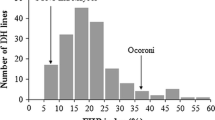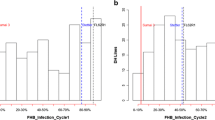Abstract
The genetic constitution of resistance to Fusarium head blight (FHB, scab) caused by Fusarium graminearum in the Chinese wheat cultivar Sumai 3 and the Japanese cultivar Saikai 165 was investigated using doubled haploid lines (DHLs) and recombinant inbred lines (RILs). Frequency distributions of DHLs derived from two F1 crosses, Sumai 3 (very resistant to resistant; VR-R) / Gamenya (very susceptible; VS) and Sumai 3 / Emblem (VS), fitted well to 1: 2: 1 (resistant: moderately resistant: susceptible) ratios for reaction to FHB in the field. It is suggested that the resistance of Sumai 3 is controlled by two major genes with additive effects. One of the resistance genes may be linked in repulsion to the dominant suppressor B1 for awnedness with recombination values 15.1 ± 3.3% in Sumai 3 /Gamenya and 21.4 ± 4.3% in Sumai 3 / Emblem. Saikai 165 is a Japanese resistant line derived from an F1 Sumai 3 / Asakaze-komugi (moderately resistant; MR). The data for RILs derived from the cross Emblem / Saikai 165, indicates that three resistance genes control the resistance of Saikai 165.
Similar content being viewed by others
References
Atanassov, D., 1920. Fusarium blight (scab) of wheat and other cereals. J Agricultural Research 20: 1–32.
Atanassov, Z., C. Nakamura, N.Mori, C. Kaneda, H. Kato, Y. Jin, T. Yoshizawa & K. Murai, 1994. Mycotoxin production and pathogenicity of Fusarium species and wheat resistance to Fusarium head blight. Can J Bot 72: 161–167.
Bai, G., C. Zhou, C. Qian, S. Xia, Y. Ge & Z. Cheng, 1990. Genetic analysis on resistant genes to scab extension in wheat. In: Advances in researches on resistance to disease in major crops. pp. 171–177. Jiangsu Sci. & Tec. Pub., Jiangsu.
Ban, T., 1991. Efficiency of 'cut-spike' inoculation method for evaluation of scab resistance in wheat. Japan J Breed 41 (suppl. 2): 404–405 (in Japanese).
Ban, T., 1997. Evaluation of resistance to Fusarium head blight in indigenous Japanese species of Agropyron (Elymus). Euphytica 97: 39–44.
Ban, T. & H. Gocho, 1988. Estimation of scab resistance in barley and wheat genetic resources. Japan J Breed 38 (suppl. 2): 410–411 (in Japanese).
Dickson, J.G., H. Johann & G. Wineland, 1921. Second progress report on the fusarium blight (scab) of wheat. Phytopathology 11: 35.
Ehling, G., A. Cockburn, P. Snowdon & H. Buschhaus, 1997. The significance of the Fusarium toxin deoxynivalenol (DON) for human and animal health. Cereal Res Commun 25: 443–447.
Fujita, M., T. Ban, K. Ujihara & R. Yoshikawa, 1988. Efficiency of scab resistance in wheat breeding. Japan J Breed 38 (suppl. 2): 412–413 (in Japanese).
Gocho, H., 1985. Wheat breeding for scab resistance. Wheat Inf Serv 60: 41.
Gocho, H., T. Hirai & T. Kashio, 1992. Breeding of 'Wheat Norin PL-4' a new germplasm with resistance to scab (Gebberella zeae (Schw.) Petch). The Bull Kyushu Natl Agric Exp Stn 27: 317–331 (in Japanese with English summary).
Hirai, T., H. Gocho & T. Kshio, 1993. A new method for testing scab resistance by controlling heading time of standard wheat varieties. The Bull Kyushu Natl Agric Exp Stn 28: 1–15 (in Japanese with English summary).
Ito, H., H. Inamura, S. Ishikawa, C. Sudo & M. Shibata, 1966. Pedigree of wheat cultivars. In: Agricultural administration investigative committee (Ed.), System Agriculture Encyclopedia, Vol. 2, pp. 180–181. Agricultural administration investigative committee, Tokyo (in Japanese).
Koizumi, S., H. Kato, R. Yoshino, N. Hayashi & M. Ichinoe, 1991a. Distribution of causal Fusaria of wheat and barley scab in Japan. Ann Phytopath Soc Japan 57: 165–173.
Koizumi, S., H. Komada, H. Kato, R. Yoshino, M. Ichinoe & N. Hayashi, 1991b. Isolation of wheat and barley scab pathogens from wheat and barley field soil in Japan. Ann Phytopath Soc Japan 57: 263–267.
Lin, Y., Z. Yang & Z. Wu, 1992. Genetic analysis of resistance to scab (Gibberella zeae) in wheat varieties from different regions. Acta Agriculture Shanghai 8: 31–36.
Liu, Z.Z. & Z.Y. Wang, 1991. Improved scab resistance in China: Sources of resistance and problems. In: D.A. Saunders (Ed.), Wheat for the Nontraditional, Warm Areas, pp. 179–188. CIMMYT, Mexico, D.F.
Mesterházy, Á., 1987. Selection of head blight resistant wheats through improved seedling resistance. Plant Breeding 98: 25–36.
McIntosh, R., G.E. Hart & M.D. Gale, 1993. Catalogue of gene symbols for wheat. In: Z.S. Li & Z.Y. Xin (Eds.), Proc 8th Intl Wheat Genet Symp (Beijing, China), pp. 1333–1500. China Agric Sci Press, Beijing.
Miller, J.D., J.C. Young & D.R. Sampson, 1985. Deoxynivalenol and Fusarium head blight resistance in spring cereals. J Phytopathology 113: 359–367.
Mujeeb-Kazi, A., M. Bernard, G.T. Bekele & J.L. Miranda, 1983. Incorporation of alien genetic information from Elymus giganteus into Triticum aestivum. In: S. Sakamoto (Ed.), Proc 6th Intl Wheat Genet Symp (Kyoto, Japan), pp. 223–231. Maruzen Co., Ltd., Kyoto.
Naito H., S. Mogi, H. Gocho & T. Hirai, 1984. A simple method for evaluation of variet al resistance to scab caused by Gibberella zeae Petch in wheat. The Bull Kyushu Natl Agric Exp Stn 23: 355–386 (in Japanese with English summary).
Nakagawa, M., 1955. Studies on ear-scab resistance of wheat plants. 2. Genetical factors affecting on the inheritance of ear-scab disease of wheat plants. Japan J Breed 5: 15–22.
Nishikado, Y., 1958a. Studies on the control of wheat scab (I). Nougaku-Kenkyu 45: 59–86 (in Japanese).
Nishikado, Y., 1958b. Studies on the control of wheat scab (II). Nougaku-Kenkyu 45: 141–158 (in Japanese).
Nishikado, Y., 1958c. Studies on the control of wheat scab (III). Nougaku-Kenkyu 45: 159–224 (in Japanese).
Nonaka, S., 1983. History of wheat breeding in Japan. In: S. Sakamoto (Ed.), Proc 6th Intl Wheat Genet Symp (Kyoto, Japan), pp. 593–599. Maruzen Co., Ltd., Kyoto.
Nonaka, S., Y. Yoshida, S. Kitahara, M. Tsuru, S. Taya & H. Araki, 1979. A New wheat cultivar 'Asakaze-komugi'. The Bull Kyushu Natl Agric Exp Stn 20: 221–237 (in Japanese with English summary).
Parry, D.W., P. Jenkinson & L. McLeod, 1995. Fusarium ear blight (scab) in small grain cereals-a review. Plant Pathology 44: 207–238.
Pugh, G.W., H. Johann & J.G. Dickson, 1933. Factors affecting infection of wheat heads by Gibberella saubinetii. J Agricultural Research 46: 771–797.
Reis, E.M., 1991. Integrated disease management-The changing concepts of controlling head blight and spot blotch. In: D.A. Saunders (Ed.), Wheat for the Nontraditional, Warm Areas, pp. 165–177. CIMMYT, Mexico, D.F.
Schroeder, H.W. & J.J. Christensen, 1963. Factors affecting resistance of wheat to scab caused byGibberella zeae. Phytopathology 53: 831–838.
Singh, R.P., H. Ma & S. Rajaram, 1995. Genetic analysis of resistance to scab in spring wheat cultivar Frontana. Plant Disease 79: 238–240.
Snijders, C.H.A., 1990a. Diallel analysis of resistance to head blight caused by Fusarium culmorum in winter wheat. Euphytica 50: 1–9.
Snijders, C.H.A., 1990b. The inheritance to head blight caused by Fusarium culmorum in winter wheat. Euphytica 50: 11–18.
Snijders, C.H.A., 1990c. Response to selection in F2 generation of winter wheat for resistance to head blight caused by Fusarium culmorum. Euphytica 50: 163–169.
Snijders, C.H.A., 1990d. Genetic variation for resistance to Fusarium head blight in bread wheat. Euphytica 50: 171–179.
Snijders, C.H.A., 1990e. Fusarium head blight and mycotoxin contamination of wheat, a review. Neth J Pl Path 187–198.
Snijders, C.H.A. & F.A. van Eeuwijk, 1991. Genotype x strain interactions for resistance to Fusarium head blight caused by Fusarium culmorum in winter wheat. Theor Appl Genet 81: 239–244.
Suenaga, K. & K. Nakajima, 1989. Efficient production of haploid wheat (Triticum aestivum) through crosses between Japanese wheat and maize (Zea mays). Plant Cell Reports 8: 263–266.
Suenaga, K., A.R. Morshedi & N.L. Darvey, 1997. Haploid production of Australian wheat (Triticum aestivum L.) cultivars through wheat x maize (Zea mays L.) cross. Aust J Agric Res 48: 1207–1211.
Takeda, K. & H. Heta, 1989. Establishing the method and search for the resistant varieties of Fusarium head blight in barley. Japan. J Breed 39: 203–216 (in Japanese with English sammary).
Takeda, K., R. Kanatani & C.L. Zhang, 1992. Variet al variation of the scab disease resistance in wheat (Triticum aestivum) evaluated by the 'cut-spike' inoculation method. Japan J Breed 42: 649–656.
Tanaka, T., A. Hasegawa, S. Tamamoto, U.S. Lee, Y. Sugiura & Y. Ueno, 1988. Worldwide contamination of cereals by Fusarium mycotoxins nivalenol, deoxynivalenol, and zearalenone. 1. Survey of 19 countries. J Agric Food Chem 36: 979–983.
Ueno, Y., N. Sato, K. Ishii, K. Sakai, H. Tsunoda & M. Enomoto, 1973. Biological and chemical detection of trichothecene mycotoxins of Fusarium Species. Applied Microbiology 25: 699–704.
Van Ginkel, M., W. Van Der Schaar & Z. Yang, 1996. Inheritance of resistance to scab in two wheat cultivars from Brazil and China. Plant Disease 863–867.
Wang, Y.Z. & J.D. Miller, 1988. Screening techniques and sources of resistance to Fusarium head blight. In: A.R. Klatt (Ed.), Wheat Production Constraints in Tropical Environments, pp. 239–250. CIMMYT, Mexico, D.F.
Weng, Y. & D. Liu, 1989. Morphology, scab resistance and cytogenetics of intergeneric hybrids of Triticum aestivum L. with Roegneria C. Koch (Agropyron) species. Scientia Agric Sinica 22: 1–7 (in Chinese with English summary).
Yang, Z., 1994. Breeding for resistance to Fusarium head blight of wheat in the mid-to lower Yangtze River Valley of China. Wheat Special Report No. 27. CIMMYT, Mexico, D.F., pp. 16.
Yoshida, H., M. Kamio & K. Kawaguchi, 1983. Evaluation of cultivars for early matureness in the Japanese wheat breeding. In: S. Sakamoto (Ed.), Proc 6th Intl Wheat Genet Symp (Kyoto, Japan), pp. 601–612. Maruzen Co., Ltd., Kyoto.
Yoshizawa, T. & Y. Jin, 1995. Natural occurrence of acetylated derivatives of deoxynivalenol and nivalenol in wheat and barley in Japan. Food Additives and Contaminants 12: 689–694.
Yu, Y.J., 1982. Monosomic analysis for scab resistance and yield components in the wheat cultivar Soo-moo-3. Cereal Res Commun. 10: 185–190.
Author information
Authors and Affiliations
Rights and permissions
About this article
Cite this article
Ban, T., Suenaga, K. Genetic analysis of resistance to Fusarium head blight caused by Fusarium graminearum in Chinese wheat cultivar Sumai 3 and the Japanese cultivar Saikai 165. Euphytica 113, 87–99 (2000). https://doi.org/10.1023/A:1003951509797
Issue Date:
DOI: https://doi.org/10.1023/A:1003951509797




